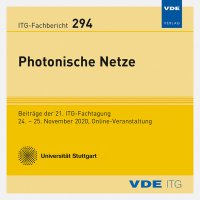Real-Time Demonstration of a 100 Gb/s THz-Wireless Fiber Extender
Conference: Photonische Netze - 21. ITG-Fachtagung
11/24/2020 - 11/25/2020 at online
Proceedings: Photonische Netze
Pages: 5Language: englishTyp: PDF
Authors:
Castro, Carlos; Elschner, Robert; Schubert, Colja; Freund, Ronald (Fraunhofer Institute for Telecommunications, Heinrich Hertz Institute, Berlin, Germany)
Merkle, Thomas (Fraunhofer Institute for Applied Solid State Physics IAF, Freiburg im Breisgau, Germany)
Abstract:
Recent work on THz-wireless technologies for data transmission has shown the potential of this type of communication to assist the existing fiber-optical network architecture, since it is possible to transmit high-speed data signals at carrier frequencies above 0.1 THz. A THz-Wireless Fiber Extender refers to a system configuration, where the transmission link is composed of fiber-optical and THz-wireless link segments. This concept relies (1) on an analog interface to enable a seamless interconnection of the fiber-optical and the THz wireless domain, and (2) on a single DSP that is robust enough to jointly compensate for the channel impairments of the combined fiber-optical/THz-wireless channel. To investigate the performance and characteristics of such high-capacity fiber-optic/THz-wireless systems, we have set up a real-time 100 Gb/s PDM-QPSK fiber-optic/THz-wireless link operating in the 300 GHz band using MMIC-based THz frontends and a high-speed digital-coherent optical modem. In the first step, we showed that the single-carrier DSP scheme carried out by the optical modem is robust enough to allow an error-free transmission of the 100 Gb/s data signal over the THz-wireless link, with stable transmission performance over multiple days of continuous operation. Using a 100 Gb/s Ethernet traffic generator, we evaluated key parameters of the Ethernet transmission like latency, frame throughput and loss of the THz-wireless link. In a second step, we introduced an analog opto-electric interface that enabled us to seamlessly connect the THz-wireless link to optical fiber(s), building a THz Wireless Fiber Extender scenario. We demonstrated that the real-time modem is capable of compensating for the combined effect of the channels’ impairments even after (in total) 100 km optical transmission before and after the transparent THz wireless link, enabling us to show-case a real-time 4k video transmission over the combined fiber-optical/THz-wireless link. Finally, to underline the prospects of THz wireless links, we have performed an outdoor transmission experiment over a 1-km long distance.


